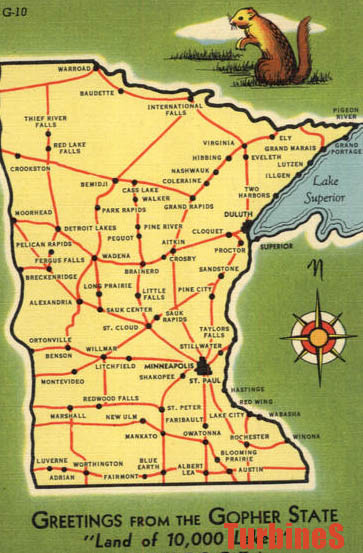
"This is merely an evolution of principles that have been evolving since the sovereign rights of eminent domain were determined to exist," according to Hugh Nierengarten, New Ulm City Attorney.
"Eminent domain is basically like a nuclear bomb," said Clete Goblirsch, a farmer who refuses to sign an easement. "The repercussions would be long lasting and widespread, not just for us, but for the wind industry."
While public utilities have fairly broad powers to use government authority to force property owners to sell to meet their needs, the New Ulm plan involves an unprecedented move to expand eminent domain authority to include the seizure of air space on private property for power generation.
"This is a first time this question has come up and the first time any entity has indicated they might use condemnation for wind development," said Bob Cupit, an expert with the Minnesota Public Utilities Commission (PUC).
The opponents' objections to the proposed five wind turbines include noise concerns, lower property values, and adverse impact on the landscape and rural atmosphere. "Nobody's against wind energy," said Jeff Franta, a farmer who's helped organize the opposition. "We're just against a project being forced on an area that doesn't want it."
Legal experts say the city would need to make the case in court that the utility would be taking wind rights for a public purpose and necessity. In a July 30, 2009 filing with the PUC, Nierengarten, on behalf of the New Ulm Public Utilities Commission, insisted "the development of clean, renewable energy should be the motivating, prudent public policy consideration, not provincial notions of "local control" and the "rural way of life.""
Acknowledging there would be "a likely furor over such an effort," Nierengarten added "it will be necessary for the City of New Ulm to exercise its powers of eminent domain to secure such rights and move this vital project forward."
New Ulm has acquired easements for 237 acres on which the wind farm would be built. A little known state requirement, however, also compels wind farm operators to obtain the so-called wind rights to about 235 acres of adjacent property in the path of the prevailing winds to assure a free flow of wind to the turbines. The city has run into turbulence with the wind farm's neighbors, who refuse to grant the necessary easements, stalling the $16-18 million project.
"Wind rights are property rights like oil, water or a gravel pit," said Franta, "Wind is like the oil in the sky so to speak. How can you use eminent domain to get something that can produce a profit for people?"
Further complicating matters, the proposed site is located about 10 miles outside of New Ulm and in a different county, leaving opponents no option for holding local officials accountable at election time. "We don't vote for city officials in New Ulm," Franta said. "It wouldn't do any good because we don't vote for them."
In its pending permit application before the PUC, the City of New Ulm has applied for a variance or exemption from the requirement to obtain the additional wind rights. That's an unlikely outcome, according to PUC staff, who expect to recommend that commissioners approve New Ulm's draft permit without a variance, setting the stage for a potential showdown.
"We (PUC) don't have powers to settle eminent domain questions," Cupit said. "We do have concerns about our permits being leveraged in this instance to force a project on a community that doesn't want it."
"If they deny the waiver and require us to acquire the wind rights, then the city and the public utility commission have to decide if they're going to do this," Nierengarten said. "Clearly the preference is to get on with the project."
"Are they going to eminent domain our land to get to the wind rights?" asks Clete Goblirsch. "If they can't eminent domain the wind rights, what's to stop them from saying, ‘fine, we'll get the land and the wind rights with the land?'"
The potentially volatile case comes at a critical time with Minnesota and the nation fast tracking green energy projects that are often fueled by federal grants, including billions in stimulus spending. Minnesota ranks fourth in overall wind production nationally with 1805 megawatts of wind-generated electrical capacity. Currently, approximately 21 wind energy projects and proposals are on the table statewide, according to the PUC.
"Until recently, utilities weren't developing wind power. It's been large private companies in most cases without eminent domain authority," Cupit said. "We're not aware of any utility in Minnesota that has used eminent domain for any wind project."
"Don't come do this to me. This is America," said Goblirsch. "Don't come and infringe on me."
The Minnesota Public Utilities Commission expects to render a decision on the matter by early January at the latest.